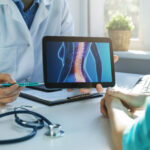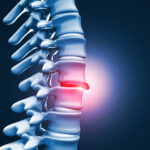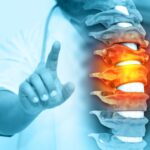
Sciatica / Lumbar Radiculopathy
Other conditions contributing to sciatica include:
- Spinal stenosis – the narrowing of the spinal canal, leading to nerve compression
- Spondylolisthesis – displacement of vertebrae, resulting in nerve pinching
- Piriformis syndrome – constriction or spasm of the piriformis muscle in the lower spine and upper leg, compressing the sciatic nerve
- Spinal tumors – tumors within or on the spine, compressing nerve roots
- Trauma – accidents, falls, or spinal impact causing nerve root injury
The risk of developing sciatica tends to increase after the age of 40, when spinal discs begin to deteriorate. Professions involving repetitive twisting or lifting, as well as prolonged driving or sitting, elevate the likelihood of sciatica. Additionally, diabetes patients are at an elevated risk due to the potential nerve damage resulting from high blood sugar.


Sciatica’s primary symptom is pain that originates in the lower back (lumbar spine), extends through the buttock, and travels down the leg. The pain’s character varies, ranging from a mild ache to an intense burning sensation or sharp jolts. Coughing, sneezing, and prolonged sitting can exacerbate the pain. Other symptoms encompass numbness or muscle weakness along the sciatic nerve’s pathway into the leg or foot. Tingling or a “pins-and-needles” sensation in the toes or foot is common. In severe cases, sciatica might lead to loss of bladder or bowel control, necessitating immediate medical attention.
The diagnostic process entails a thorough medical history inquiry and a physical examination. Muscle tests are conducted to assess strength and reflexes. In mild cases, sciatica often improves on its own. If the pain is severe or related to a serious medical condition, further diagnostic tests may be ordered. These tests include X-rays to examine the lower spine’s bones, MRI scans to identify herniated discs, CT scans, or myelograms to evaluate the spinal cord and nerves.
Conservative treatments typically yield positive outcomes for sciatica, including hot and cold packs, stretching, exercise, and over-the-counter pain medications. When a herniated disc is responsible, physical therapy is often recommended. Pain medications or epidural steroid injections might be prescribed by a doctor. More aggressive treatments are usually considered only when conservative methods prove ineffective.
Surgical intervention for sciatica is generally contemplated when symptoms persist despite conservative treatment. If a herniated disc is the cause, surgery is performed to remove the disc fragment compressing the affected nerve thus relieving the symptoms.
Book an appointment
"*" indicates required fields










